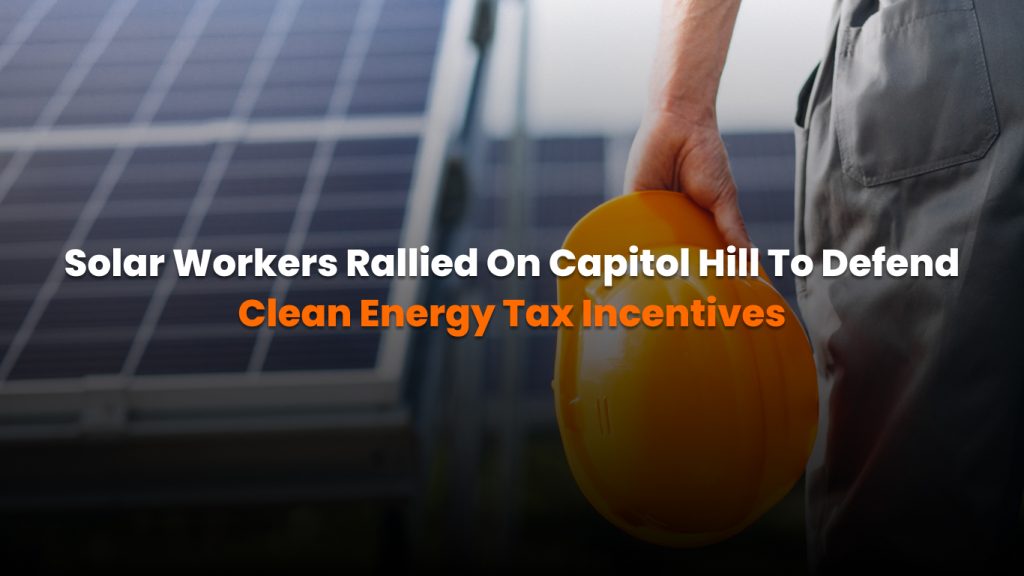In mid-June, more than 500 solar workers, including installers, electricians, small business owners, and factory technicians, gathered on the West Front Lawn of the U.S. Capitol to urge lawmakers to protect federal clean energy tax incentives. Organized under the “Save Main Street Solar” campaign, the rally served as a powerful display of concern from an industry facing major setbacks due to proposed changes in federal policy.
The demonstration took place on June 17, just hours after the Senate Finance Committee released draft language that mirrored many of the clean energy rollbacks already passed by the House of Representatives. Among the most critical changes in the draft were proposed cuts to the residential Investment Tax Credit (ITC) and new limits on credit transferability—two key provisions introduced under the Inflation Reduction Act (IRA) that have been instrumental in supporting solar adoption and job creation across the country.
“Time to storm the Hill!” SEIA President and CEO Abigail Ross Hopper told the crowd. “We are in a fight for our lives,” she added, emphasizing that “330,000 jobs are at stake” if the proposed cuts went through.
Workers from solar companies in swing states like Texas, Ohio, and West Virginia stood side by side, wearing hard hats emblazoned with their company names. Many of them shared stories of how the ITC had helped grow their businesses and provide steady employment in their communities.
Jeremy Brooks, a journeyman electrician from Columbus, Ohio, said the changes would hit his company hard. “Our company cancels every fourth job on the board – that is my crew’s rent and grocery money disappearing overnight,” he said.
Dan Conant, founder of Solar Holler, warned that many small towns in West Virginia, which had recently transitioned from coal to solar, would be devastated by the proposed cuts. “Shutting off the credit spigot strips job options from the very towns Congress promised to revitalize,” he said.
Earlier in June, SEIA released state-by-state projections that showed the tax credit rollback could lead to the closure or cancellation of 331 solar manufacturing sites and wipe out $286 billion in planned local investment. Texas alone stood to lose over 34,000 jobs by 2030, as noted by Solar Power World.
Following the rally, solar workers split into groups and visited more than 80 Senate offices. They left behind data packets and shared polling results that showed 72% of voters supported keeping the solar tax credit through at least 2032. Many also cited a report from the American Clean Power Association warning that removing the tax credits would lead to an increase in household electricity costs by as much as 8% over the next decade.
Despite the urgency, Hopper told rally participants not to lose hope. “We are not at the end… This is not done. You have the opportunity today to tell these legislators what this means to you,” she said.
Opponents of the tax credit program, particularly members of the House Freedom Caucus, argued that the subsidies distorted the energy market and benefited foreign manufacturers. However, even business-aligned groups like the U.S. Chamber of Commerce called for a slower phase-out, signaling a growing divide over how to handle the future of clean energy policy.
Meanwhile, a conservative group called Built for America launched a $2 million ad campaign framing energy tax credits as “pro-growth and patriotic.” Supporters of the credits, however, argued that the ads failed to account for the impact on manufacturing sites already under construction.
Senate leadership was expected to move forward with reviewing the Finance Committee’s draft bill before the July 4 recess, leaving little time for advocates to push for changes. Rally organizers said they would continue to put pressure on lawmakers and are planning another “Solar Day of Action” later this summer.
Reflecting on the event, Hopper emphasized the importance of showing up: “I would not ask you to travel here, take time away from your families, take time away from your businesses, if I thought that this was done.”
The June 17 rally, supported by industry data and grassroots voices, marked a critical moment for the solar industry—a show of unity and determination in the face of legislative uncertainty.




